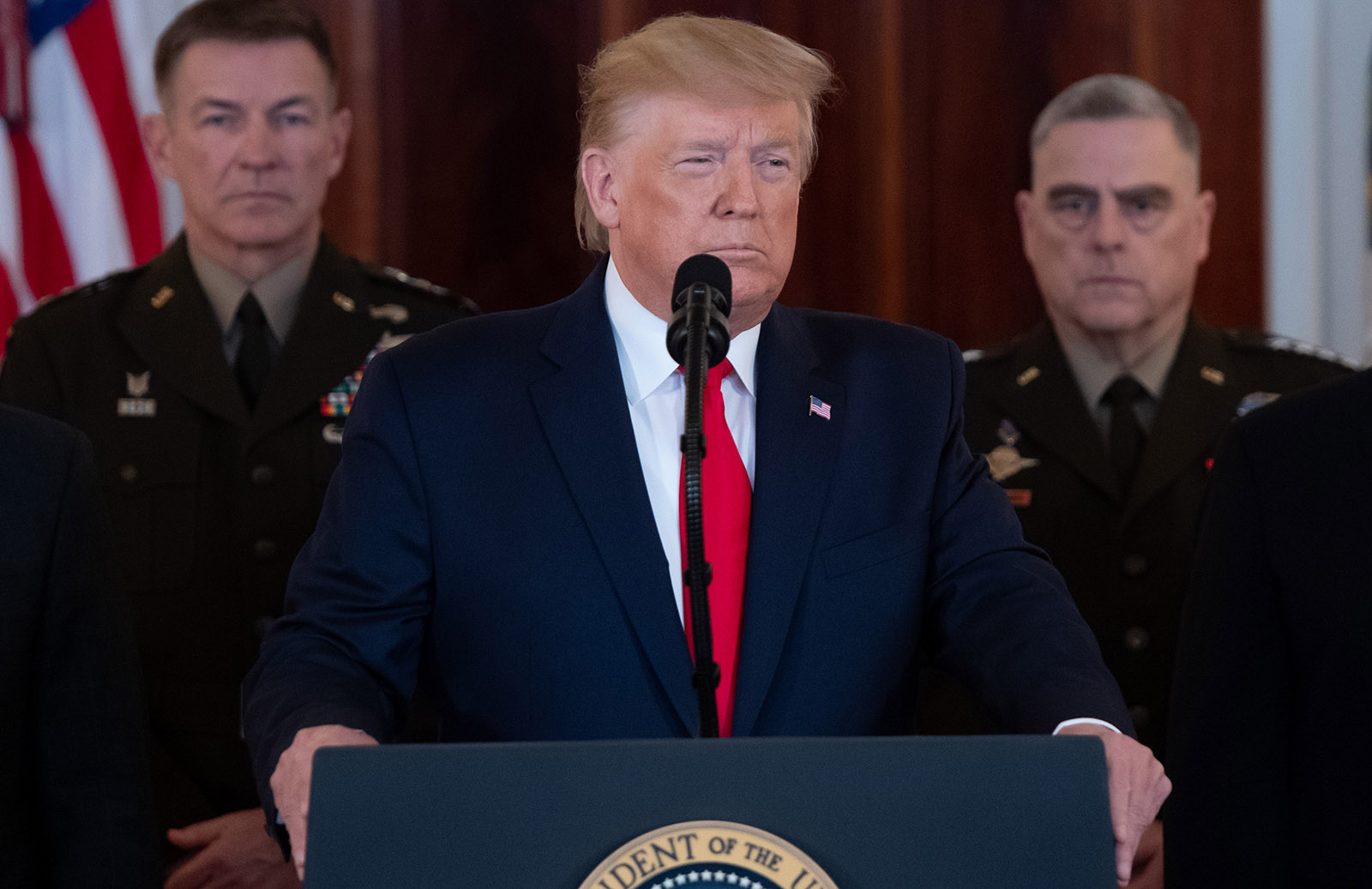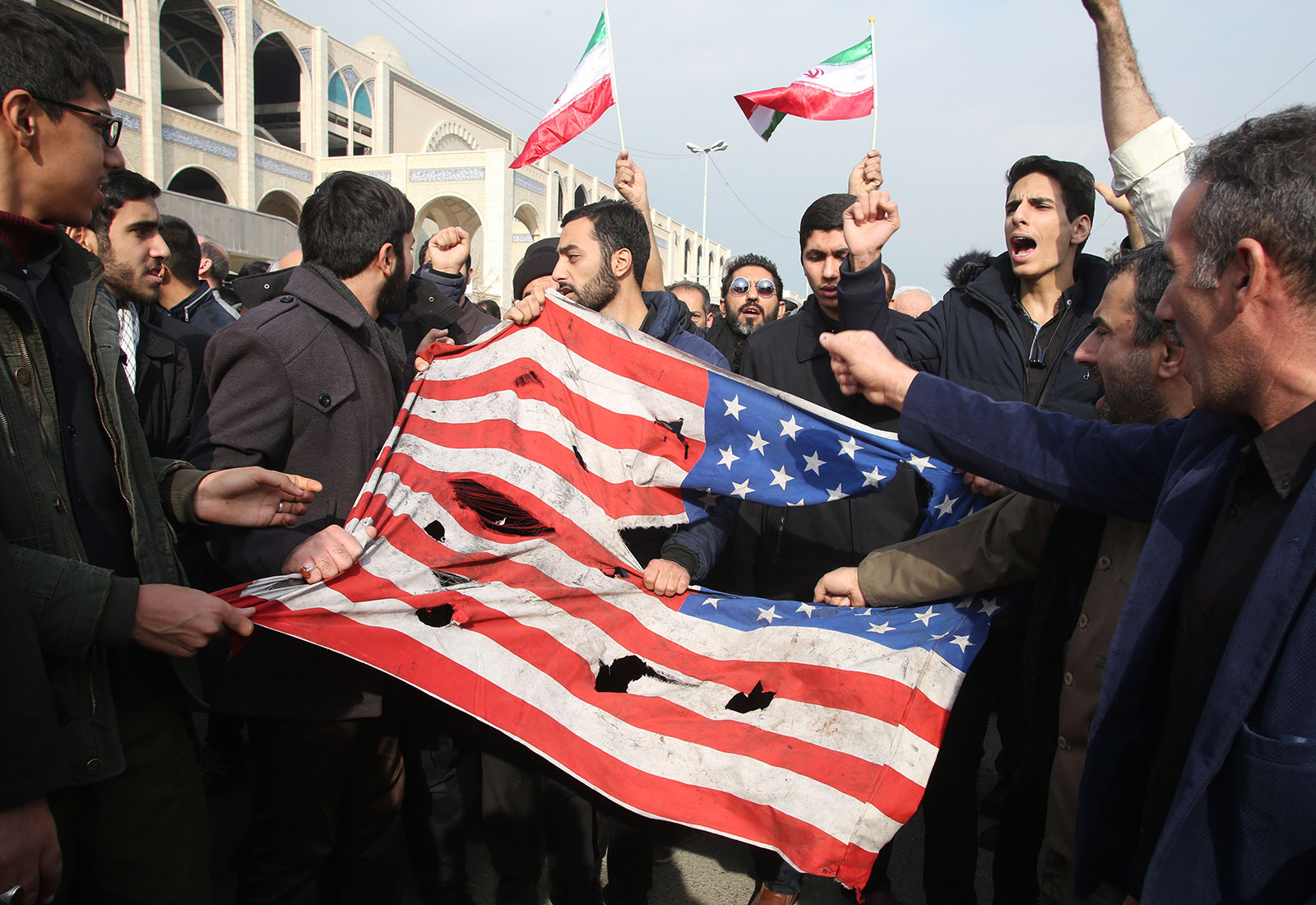In a major speech in May 2018, Secretary of State Mike Pompeo outlined how the Trump administration sought to make Americans more secure from attack by Iran, deny that adversary a path to acquiring nuclear weapons, stop Iranian-backed terrorism, and reduce Iranian influence in the Middle East. By affirming these objectives, Secretary Pompeo was broadly adhering to the bipartisan consensus on US–Iranian policy that has prevailed for the last half-century. But to achieve these goals, President Trump and his administration adopted a radically different strategy from the previous administration’s.
President Obama and his administration made denying Iran a nuclear weapon their highest priority, and then deployed a mix of coercive and engagement policies—economic sanctions, cyber-attacks on Iranian nuclear facilities, as well as direct bilateral diplomacy—to persuade the Iranian government to negotiate an agreement to constrain Iran’s nuclear weapons program, which came to be known as Joint Comprehensive Plan of Action (JCPOA). Trump unilaterally withdrew from the JCPOA, lambasting the agreement as the worst deal ever, and instead imposed new economic sanctions to pursue what the Trump administration has called a “maximum pressure campaign.” Some on Trump’s team also advocated regime change—notably, Secretary Pompeo himself and former National Security Adviser John Bolton. Most dramatically, Trump escalated the confrontation last week by ordering the killing of General Qassem Soleimani, head of the Iranian Quds Force, and the Iraqi militia commander Abu Mahdi al-Muhandis.
Three years later, has this new pressure campaign brought the United States any closer to achieving any of the Trump administration’s own stated foreign policy objectives? No, just the opposite.
Without question, Soleimani was an enemy of the United States and its partners. He and his proxies had killed hundreds of US citizens in terrorist attacks during the peak fighting of the Iraq War. He was also responsible for the deaths of tens of thousands of innocent civilians in Syria, Iraq, Afghanistan, and Iran. The Trump administration has claimed—in intelligence that it has kept classified—that Soleimani was plotting new, imminent attacks against US targets. While that behavior would be consistent with his ruthless activities in the region in past years, it is important to remember that Iranian proxies were not killing or targeting Americans between the negotiation of the JCPOA and the end of the Obama administration. Iranian attacks against the United States and our partners have increased during the Trump administration. The erosion of deterrence, which Secretary Pompeo argued had to be “restored” by killing Soleimani, developed over the three years of the Trump administration, not before.
Secretary Pompeo has also said: “I can assure you Americans in the region are much safer today after the demise of Qassem Soleimani.” Yet the US government’s advice to Americans to evacuate Iraq, the commander-in-chief’s decision to send more soldiers to the region, and this week’s Iranian missile attacks on Iraqi military bases where American soldiers are stationed all underscore that Americans in the region are far from safe.
Neither has Trump’s strategy produced a better nuclear deal to replace the JCPOA. Not only is there no deal, there are not even negotiations. In the wake of Soleimani’s assassination, the government in Tehran announced its decision not to abide by any limits on its nuclear activities. Mahmoud Sadeghi, an Iranian member of parliament once considered a moderate, even introduced a bill demanding Iran’s withdrawal from the Nuclear Non-Proliferation Treaty.
As for Iranian power and influence in the region, it has expanded, not shrunk, over the last three years. When Trump ordered a US military withdrawal from Syria last year—though partially reversed soon after—he handed over control of large swaths of the country to President Bashar al-Assad and the Iranian and Russian allies of his brutal regime. Saudi Arabia’s oil fields came under attack from Iran not in the Obama era, but on Trump’s watch.
Now, days after the Soleimani assassination, the Shiite majority in the Iraqi parliament passed a non-binding resolution calling on the Baghdad government to expel US forces. (Sunni and Kurdish members of the parliament did not vote for the resolution.) The ouster of an American military presence in the country is a long-time Iranian objective. Already, the Pentagon has suspended military operations against the Islamic State in Iraq to focus instead on protecting US soldiers and civilians based at Iraq bases from attacks by Iran-backed militias. If American soldiers do eventually leave Iraq, it will be Iran and ISIS that fill the vacuum.
Trump threatened that if Iraq went ahead with this action, “We will charge them sanctions like [sic] they’ve never seen before ever. It’ll make Iranian sanctions look somewhat tame.” These sanctions would target a long-standing American partner—a rather illogical method of strengthening American influence and weakening Iranian control in the region.
Advertisement
Tragically, this reversal in Iraqi sentiment toward the United States has occurred at a moment when large sections of Iraqi society, Sunni and Shiite alike, were mobilizing against Iranian interference. Just weeks ago, mass demonstrations and boycotts of Iranian goods took place to protest the heavy-handed actions, often encouraged by Soleimani, of Iraq’s Shiite-dominated government. The assassination of Soleimani has, for now, quashed that movement, and instead inspired renewed Iraqi animus against the United States.
Tehran’s support for terrorist organizations and militias has not markedly declined because of “maximum pressure.” Trump’s new economic sanctions, assisted by growing corruption in the Iranian economy, has reduced Iranian financial support for its proxies in the region. That is a good outcome, but there is no evidence that relations between Tehran and these paramilitary and terrorist organizations have frayed or that they’ve been forced to reduce their activities. In recent months, Iranian officials have met with leaders of Hezbollah, different radical Shiite groups from Iraq, leaders of Yemen’s Houthi movement, as well as Palestinian Islamic Jihad and Hamas, to reiterate Iran’s continued support. The Hamas leader Ismail Haniyeh was an honored speaker at Soleimani’s state funeral. We can now expect these ties to deepen, not diminish.
The death of Soleimani has also thrown a lifeline to Tehran’s beleaguered ruling elite. Only months ago, Iran’s autocratic regime faced a new wave of street protests from hundreds of thousands of Iranians, including many of the society’s poorest. The theocrats ruling Iran showed their fear of the popular movement when their security forces put down the demonstrations with live fire, killing hundreds, and arresting thousands. But after Soleimani’s death, the streets of Iran are now filled with pro-regime, anti-American protesters.
In the frenzied atmosphere of the state funeral and fear of war, past fissures within the ruling regime, however faint before, have now completely disappeared. Iranian democratic activists, including those who have been fierce critics of Soleimani and his Islamic Revolutionary Guards Corps, cannot now openly challenge the regime. Iranian public sentiment against the dictatorship is deep. If the current escalation of tensions between the United States and Iran subsides, popular mobilization against the regime will return. The opposite is also true: greater conflict, especially all-out war with the United States, will only strengthen the regime.
An escalating conflict in the Middle East will also shift Washington’s attention away from a stated administration aim of focusing on great-power competition with China and Russia. Ironically, the US is now distracted from addressing a rising China and a belligerent Russia exactly when these two countries are increasing their influence in Iran, the Persian Gulf, and the Middle East beyond. For the first time in history, after three years of Trump’s “maximum pressure,” China, Iran, and Russia have just conducted joint naval exercises in the Persian Gulf. In addition, Russia will soon lease the port of the Iranian city of Bushehr, where Russia has been building a nuclear reactor for Iran and has signed agreements to build yet another.
More broadly, Trump’s current Iran strategy has accelerated American isolation. Few countries supported the US decision to abandon the Iran nuclear deal. The Israeli government initially praised the attack on Soleimani, but then Prime Minister Benjamin Netanyahu signaled a desire to keep Israel out of this bilateral conflict. NATO issued a notably tepid statement of support. One-time US allies Afghanistan, Iraq, and Turkey have all announced they would not allow their territory to be used to launch attacks against Iran. Even Saudi Arabia has in recent months begun to negotiate secretly with Iran (in an apparent effort to reduce regional tensions).
Some Trump administration officials and their supporters continue to blame President Obama for America’s troubles with Iran. But Trump and his team started tearing up Obama’s legacy three years ago. During his presidency, Trump’s strategy of “maximum pressure” and “restoring deterrence” have weakened America’s position on every count of its stated policy objectives in the region, while simultaneously, at least in the short run, strengthening the most conservative elements within the Iranian regime. Compared to three years ago: we have no nuclear agreement with Iran, let alone a more comprehensive one; we have enabled greater Iranian influence in the region, especially in Syria and Iraq, not less; and we have seen the Islamic Republic’s theocratic order become more repressive and entrenched, not more open or democratic.
So far, thankfully, the US assassination of Soleimani and the Iranians’ cautious military response have not led to open conflict—though past Iranian behavior suggests that we have not seen Iran’s full response. Given Iran’s dire economic situation and its huge military inferiority to US capabilities, the regime in Tehran is unlikely to provoke a direct shooting war with the United States. But since when did avoiding a war with Iran become America’s sole security objective?
Advertisement
When it comes to other central US security goals—denying Iran a nuclear weapon, ending Iran’s support for terrorism, reducing Iran’s influence in the Middle East, to say nothing of more ambitious goals of promoting democracy in Iran or checking Chinese and Russian influence—Trump’s strategy for dealing with Iran has produced no progress. Some might see the removal of Soleimani from the battlefield as a tactical win, but it is one likely to fuel far greater strategic setbacks over the long run.



